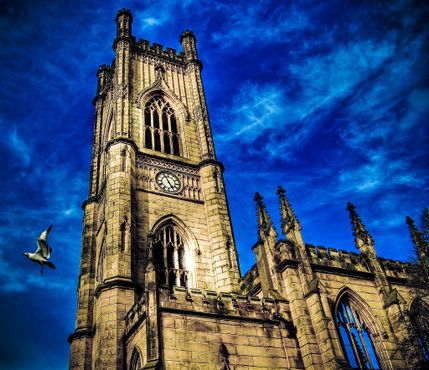Liverpool is an incredibly beautiful city with a rich history, divine architectural objects and green zones. Every street and every building in this city fascinates and attracts a lot of tourists. In this article, we will tell you about St Luke’s Church, which is also known as the bombed-out church. It’s not only an architectural landmark but also a memorial commemorating victims of the war. Learn more about its history at liverpool-future.com.
History of creation
The history of St. Luke’s Church began back in 1791 when Earl Edward Smith-Stanley allocated a site for its construction. However, he had one condition, this plot of land must never be used for other purposes. That is, only the church could be built on the allocated site. The construction project was drawn up in 1802, but the first stone was laid nine years later.
It should be noted that the construction work proceeded very slowly and the plan was gradually changed. Thus, the church was made suitable not only for religious gatherings but also for holding various events.
The church was finally built in 1832. In those days, it was also called the doctor’s church because of many doctors living nearby. From the very beginning, the church served not only for religious services but also as a concert hall. It lasted until the Philharmonic Hall was built in 1849.

From the bombed-out church to the present
Liverpool suffered an attack in May 1941. St Luke’s Church was also damaged. It caught fire and only the burnt remnants remained of the former church. That was when it began to be called the bombed-out church. The authorities decided to leave everything as it was as a sad reminder of those who died in the war. Later, the temple was recognised as a Grade II listed Building.
In addition, the fire destroyed a lot of interior features. The church had two aisles and a heavily ornamented ceiling. The entire roof has been destroyed, so we will never see its groined ceiling again, as well as the arcades and stained-glass windows. In 1818, the church was decorated with eight bells forming a ring. Five bells fell down during the fire and the other three cracked. The clock and the organ were also destroyed.
In the modern period, the church houses various exhibitions, events and film screenings. The building became a creative centre for local residents.
Exterior
Sometimes, the surrounding area of a church was used for burials. However, the site around the bombed-out church was laid out as a garden. It happened in 1885. At first, it was enclosed by a solid wall, which was replaced later.
There is also a monument to the victims of the Irish Famine. It was opened in 1998. In the garden, you can also come across a sculpture depicting German and British soldiers. It is called the Christmas truce statue.
St Luke’s Church is an incredible architectural monument. Many tourists come here to enjoy the harmonious combination of stone and vegetation. Admiring the remains, you come to the conclusion that nothing is eternal in this world. After all, war can destroy even the most beautiful objects, houses and cities.
The outside of the church is decorated with stucco and each piece depicts a biblical story. Even though services haven’t been held in the bombed-out church for many decades, this is a spot of peace, silence and divine aura. This is a wonderful place for prayer and communication with God.
We hope that our article was interesting and you learned more information about Liverpool. How often do you visit St Luke’s Church? We are waiting for your comments on our social networks.